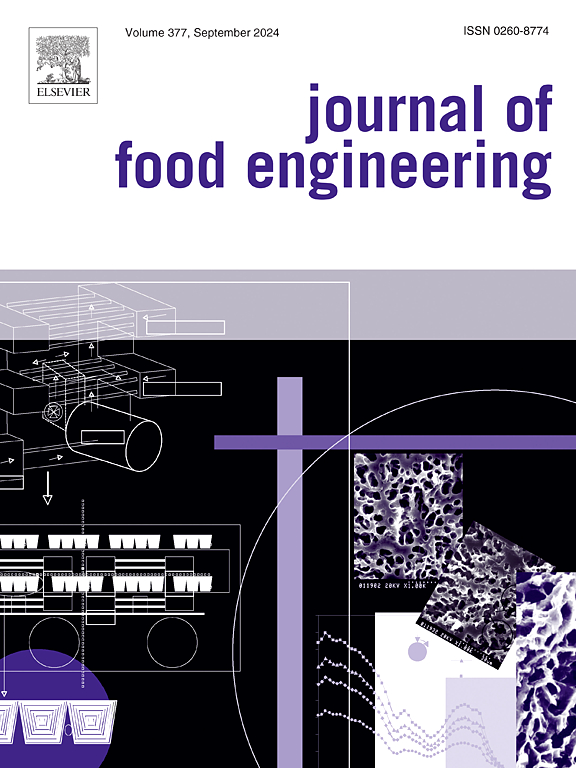Impact of extrusion cooking on tree bean (Parkia timoriana) seed protein emulsion gels with natural deep eutectic solvents and its use as an extrusion-based 3D food printing ink
IF 5.8
2区 农林科学
Q1 ENGINEERING, CHEMICAL
引用次数: 0
Abstract
This study investigates the effects of single-screw extrusion on the stability and functional properties of emulsion gels containing tree bean seed protein (45–60 % w/w), starch, lipids, and natural deep eutectic solvents (NADES)- a novel, green solvent system known to enhance protein interactions. The extrusion process was optimized by evaluating the influence of temperature, screw speed, moisture content, and NADES concentration on critical parameters such as viscosity, compression energy, and peak force. The optimized conditions (93.33 °C, 155.41 rpm, 48.38 % moisture content, and 3.33 % NADES) yielded emulsion gels with improved textural and thermal properties. Notably, the inclusion of NADES enhanced protein thermal stability, with a denaturation temperature range of 136.5–147.2 °C, indicates the formation of stable quaternary complexes. Rheological analysis revealed that emulsion gel with NADES exhibited superior structural uniformity, reduced viscosity, and enhanced flow properties, making them ideal candidates for extrusion-based 3D food printing. Furthermore, 3D-printed meat analogues derived from these emulsion gels demonstrated high shape retention and softness comparable to raw chicken meat. This research highlights the potential of integrating NADES with extrusion technology to develop sustainable, plant-based meat analogues with improved structural and functional characteristics, addressing key challenges in the field of alternative protein foods.
用天然深共晶溶剂挤压蒸煮对树豆(Parkia timoriana)种子蛋白乳液凝胶的影响及其作为挤压型3D食品打印油墨的用途
本研究研究了单螺杆挤压对含有树豆籽蛋白(45 - 60% w/w)、淀粉、脂类和天然深共晶溶剂(NADES)的乳液凝胶的稳定性和功能特性的影响。NADES是一种新型的绿色溶剂体系,已知可增强蛋白质相互作用。通过考察温度、螺杆转速、水分含量、NADES浓度对黏度、压缩能、峰值力等关键参数的影响,优化挤出工艺。优化条件(93.33°C, 155.41 rpm, 48.38%含水率,3.33% NADES)得到的乳液凝胶具有较好的结构和热性能。值得注意的是,NADES的加入增强了蛋白质的热稳定性,变性温度范围为136.5 ~ 147.2℃,表明形成了稳定的季元配合物。流变学分析表明,含有NADES的乳液凝胶具有优异的结构均匀性,降低了粘度,增强了流动性能,使其成为基于挤压的3D食品打印的理想候选材料。此外,由这些乳液凝胶衍生的3d打印肉类类似物显示出与生鸡肉相当的高形状保留和柔软度。这项研究强调了将NADES与挤压技术相结合,开发具有改进结构和功能特征的可持续植物性肉类类似物的潜力,解决了替代蛋白质食品领域的关键挑战。
本文章由计算机程序翻译,如有差异,请以英文原文为准。
求助全文
约1分钟内获得全文
求助全文
来源期刊

Journal of Food Engineering
工程技术-工程:化工
CiteScore
11.80
自引率
5.50%
发文量
275
审稿时长
24 days
期刊介绍:
The journal publishes original research and review papers on any subject at the interface between food and engineering, particularly those of relevance to industry, including:
Engineering properties of foods, food physics and physical chemistry; processing, measurement, control, packaging, storage and distribution; engineering aspects of the design and production of novel foods and of food service and catering; design and operation of food processes, plant and equipment; economics of food engineering, including the economics of alternative processes.
Accounts of food engineering achievements are of particular value.
 求助内容:
求助内容: 应助结果提醒方式:
应助结果提醒方式:


